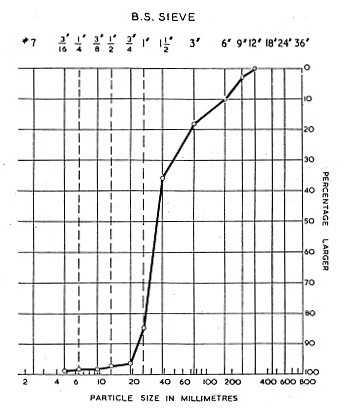DIAMOND DRILLING FOR FOUNDATION EXPLORATION-Moye

Fig. 2.—Grading curve derived from the Fracture Log of Drill Hole 6022.
Water Level.
—The water level in the completed drill hole is measured periodically to study fluctuations in the water table with seasonal changes in precipitation, and also in some cases to observe changes resulting from the filling or emptying of nearby dams and tunnels.
Drilling Water Loss, Per Cent.
—The drillers make a crude estimate of the percentage of drilling water lost during circulation which is useful as a rough indication of permeability. It is interesting to note that quite often as drilling proceeds the drilling water returns after having been lost indicating that openings m the rock around the hole have been clogged by drill cuttings.
Water Pressure Tests.
—Drill holes at dam sites along canals and close to tunnels are tested, as described in more detail below. The results are plotted graphically as Lugeon Units.
Tests in Drill Holes—Water Pressure Tests:
The holes are systematically tested during the drilling of the hole. After the hole has advanced a certain distance, usually about 20 ft., drilling is suspended and the test carried out by placing a packer 20 ft. above the bottom of the hole and pumping water into this section at a constant pressure measured on a gauge at the ground surface. The rate of flow out of the hole, measured on a water meter, usually becomes practically constant in a short time and it is then measured over a 5 min. period. Tests are made at three different pressures, the maximum pressure not exceeding the vertical rock pressure at the test section, roughly calculated as one lb./sq-in/ft. of cover. This is to avoid uplift. Drilling is then resumed and after another 20 ft. the hole is again tested.
Testing in stages during drilling has been adopted to minimise, as far as practicable, reductions in permeability caused by drill cuttings being carried into the openings in the rock mass and also so that one packer only need be used. The alternative system of water pressure testing the hole after it has been drilled to final depth is not favoured because under this system blocking of permeable openings by drill cuttings would be at a maximum, and also two sets of packers would be required to test separate sections of the hole.
Drilling mud is never used in spite of the acknowledged advantages which it gives when drilling through unstable ground. The use of mud would prevent water pressure testing and meaningful observations on the water table.
